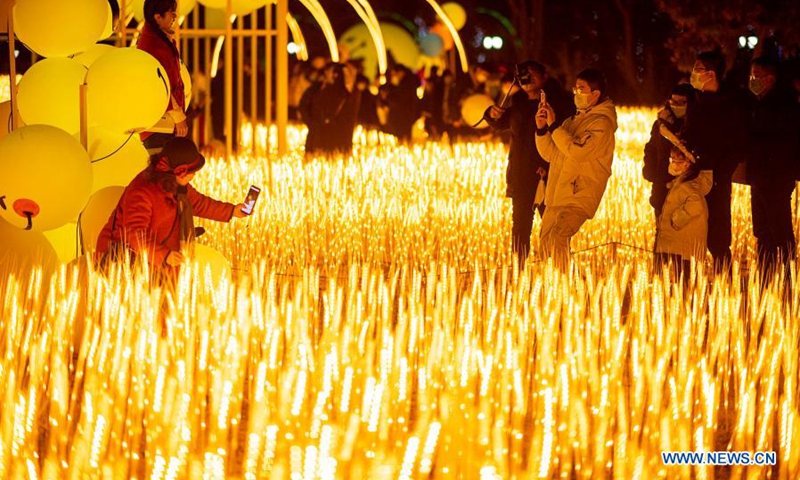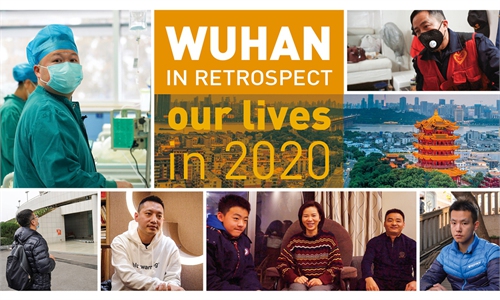One year on from Wuhan lockdown: Resolute actions bring economy back on stellar growth path

Tourists pose for photos at the Happy Valley Wuhan theme park in Wuhan, central China's Hubei Province, Jan. 1, 2021. People came to have fun and enjoy the view at the Happy Valley in Wuhan to greet the New Year on Friday. (Xinhua/Xiong Qi)
If China's economic growth of 2.3 percent last year despite the headwinds of COVID-19 can be considered a silver lining to the virus-dragged global economy, then the country's central city of Wuhan, the first city that experienced an unprecedented lockdown at the beginning of 2020 after an epidemic outbreak, could serve as a model for other Chinese cities and the world to emerge from the health crisis even stronger.
Despite tremendous hardships in recovering its industries and enhancing local people's consumption power that have been hit severely by the virus, which brought Wuhan's economic performance ranking below most of its peers, the city has already returned to its vigor and strived to catch up this year.
Wuhan's economic output, which accounted for around 37 percent of the province's total, is estimated to record negative growth of 6-8 percent for the full year of 2020, based on the province's GDP growth rate of negative 5 percent in the same period, Dong Dengxin, director of the Financial Securities Institute at Wuhan University of Science and Technology, told the Global Times on Friday.
"Compared with a negative growth of 40.5 percent in the first quarter of 2020, when the ravaging virus grounded all economic activities to a halt, the city's robust recovery in the second half is unimaginable and stunning," Dong noted.
Wuhan's GDP data is expected to be unveiled soon.
Effective prevention measures, people's raised awareness of social distancing and wearing masks, and local enterprises' quick response to coordinate resources to guarantee the supply chain have played a key role in the virus battle and Wuhan's fast recovery after the 11-week lockdown that put the city in virtual quarantine, observers said.
China started lockdown on Wuhan on January 23, 2020 just ahead of the eve of Lunar New Year, one of the country's biggest holidays. The lockdown was eventually lifted on April 8.
"I still remember the day I got the news that the railway was closed and we could not return to our hometown. Things suddenly became gloomy and our worry over the virus was also amplified," Wang, a frontline manager in charge of production in an auto firm in Wuhan, recalled.
"Not to overstate things, but I dared not open my home's window for too long each day during the period trapped home in fear that the wind blew in might carry the virus," Wang told the Global Times.
Following the end of Spring Festival in February last year, Wang said his team started to meet online each day discussing preparations for resuming production while waiting for further notification from the local government.
"To our relief, our facility's output climbed back to pre-epidemic level within just a few days after we officially resumed production in April, although there were some obstacles caused by a lack of workers and auto components," Wang said.
He estimated a positive year-on-year growth of production in 2020 for the auto firm he works for. "And I bet we are not alone. Some peers in the industry would also achieve that."
Dubbed China's Detroit, Wuhan accounted for nearly 10 percent of vehicles made in China and is home to hundreds of parts suppliers.
Wang also expressed some sadness over his thinning pocket. "Our family income shrank a bit last year and we spent less on consumption."
Latest data showed that Hubei's per capita disposable income in 2020 slid to 27,881 yuan ($4,308) compared with 28,319 yuan of the previous year due to the virus' impact, the only province that recorded a negative growth in the Chinese mainland. Shanghai topped the list with 72,232 yuan.
Many netizens last year expressed their willingness to go sightseeing in Wuhan, the heroic city, boosting local tourism from freezing point in the first quarter to peak in the second half.
Within a week since the lockdown lift on April 8, tourism ticket searches for Wuhan increased by nearly 70 percent. Thanks to the tourism campaign launched in August, visitors to the city surged to a peak.
For Shen Dongfeng, general manager of Wuhan's Jiuzhou Travel Agency, the year of 2020 was a roller coaster - diving into bottom in the first half and then a jump at high speed in the fourth quarter.
The agency's business achieved positive growth on a yearly basis last year, Shen told the Global Times on Thursday. To his knowledge, about one third of local travel agencies generated higher revenue compared with the previous year thanks to the boom since the second half.
"Orders began picking up slowly in June and then accelerated since August. From September to the end of last year, recovery was at full swing," Shen said.
During the eight-day Golden Week holiday, Wuhan received 18.18 million tourists, returning to 80.34 percent of the same period of the previous year; reaching tourism income of 8.98 billion yuan, 71.31 percent the level of the same period of 2019.
Visitors toured the Yellow Crane Tower as the historic building launched night tours for the first time since its opening to the public in 1985. The landmark topped the "country's hottest scenic spots" rankings by China's tourism service provider Trip.com.
"Different from pre-epidemic period, tourists tend to take in-depth visits and they stay longer for more scenic spots," Shen said.
Given the current strict virus prevention measures ahead of the Spring Festival holiday travel, tourism to Wuhan has now moderated. "If we take a measured approach to public health restrictions, I think the city can again embrace its travel peak in March," Shen noted.
GDP beating expectations
Official data released on Tuesday showed Hubei's GDP contracted by just 5 percent last year to 4.34 trillion yuan ($670 billion), beating economists' expectations of a double-digit decline. It is the only province that recorded a negative year-on-year GDP growth among the 18 provinces and municipalities that have so far announced their economic performance.
For Wuhan, its GDP from January to September 2020 reached nearly 90 percent of the same period the previous year. The decline of 10.4 percent in the first three quarters was an improvement from the 19.5 percent decline of the first half.
"The city's GDP growth for the full year of 2020 was estimated near the level of the province - minus 5 percent," said Ye Qing, deputy director of the Statistics Bureau of Hubei Province.
"Almost all the major enterprises in Wuhan have run their businesses normally particularly after April, which acts as a stabilizer for the city to carry on," Ye told the Global Times, noting that the city would register a stellar growth this year.
Holding an optimistic view of Wuhan and the province's economic outlook, Tian Yun, vice director of the Beijing Economic Operation Association, believes their GDP will achieve double-digit growth in 2021.
Different from previous crises, COVID-19 has made a heavier blow to supply. Looking back, Wuhan's resolute and timely lockdown was such a swift reaction to the emergency. With effective virus prevention measures in place, it accelerated the pace to put work resumption on the agenda. Thus, the supply side is guaranteed, Tian told the Global Times on Thursday.
In this sense, Wuhan serves as a model for both domestic and foreign cities to follow, Tian pointed out. In addition, the city has not only survived but also turned the health crisis into an opportunity to grow stronger: improved social governance and public health, industrial upgrades and becoming more digitized, making headway to becoming an international metropolis.
"The original advantage of Wuhan was not diminished through the crisis, instead it was reinforced," Ye said. For instance, based on the strategic location Wuhan boasts, reputed as the "crossroads between nine provinces," more hospitals are being built in the city in quick response to any emergency in the future and it has become a key pivot for the distribution of epidemic prevention supplies.
"A few months ago, Wuhan was the center of the epidemic, but now it has become the weather vane of China's post-epidemic economic development," Yang Yuanqing, chairman and CEO of Lenovo, said in September when the world's first 5G foldable mobile phone, Motorola Razr 5G, officially rolled off production line at Lenovo's Wuhan industrial site.
More firms, from home and abroad, attracted by the resilience and vitality of Wuhan, have flocked to the city after its rebirth, establishing headquarters or expanding investment.
US industrial conglomerate Honeywell was the first Fortune 500 firm that invested in Wuhan after its lockdown lift by opening of its emerging market headquarters and innovation center in the city.



